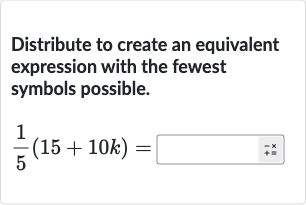Full solution
Q. Distribute to create an equivalent expression with the fewest symbols possible.
- Distribute the fraction: Distribute the fraction to both terms inside the parentheses .Calculation:
- Simplify each term: Simplify each term.Calculation: and
- Write the simplified expression: Write the simplified expression.Calculation:
More problems from Domain and range of relations
QuestionGet tutor help
QuestionGet tutor help

